冗余资源与绩效之间的关系:来自中国的实证研究(IJMECS-V3-N1-1)
- 格式:pdf
- 大小:137.45 KB
- 文档页数:8
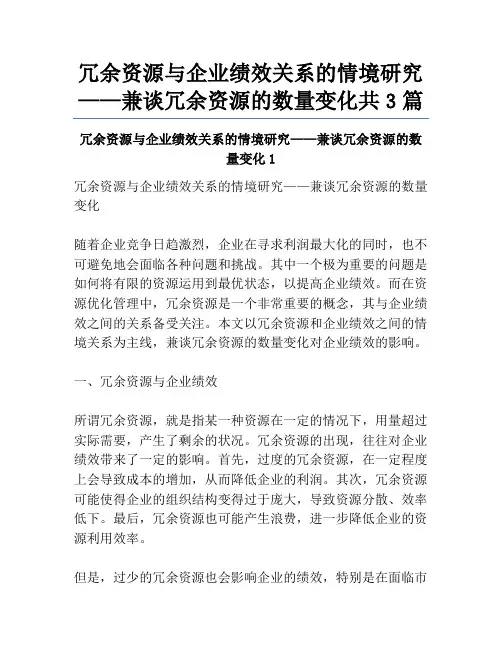
冗余资源与企业绩效关系的情境研究——兼谈冗余资源的数量变化共3篇冗余资源与企业绩效关系的情境研究——兼谈冗余资源的数量变化1冗余资源与企业绩效关系的情境研究——兼谈冗余资源的数量变化随着企业竞争日趋激烈,企业在寻求利润最大化的同时,也不可避免地会面临各种问题和挑战。
其中一个极为重要的问题是如何将有限的资源运用到最优状态,以提高企业绩效。
而在资源优化管理中,冗余资源是一个非常重要的概念,其与企业绩效之间的关系备受关注。
本文以冗余资源和企业绩效之间的情境关系为主线,兼谈冗余资源的数量变化对企业绩效的影响。
一、冗余资源与企业绩效所谓冗余资源,就是指某一种资源在一定的情况下,用量超过实际需要,产生了剩余的状况。
冗余资源的出现,往往对企业绩效带来了一定的影响。
首先,过度的冗余资源,在一定程度上会导致成本的增加,从而降低企业的利润。
其次,冗余资源可能使得企业的组织结构变得过于庞大,导致资源分散、效率低下。
最后,冗余资源也可能产生浪费,进一步降低企业的资源利用效率。
但是,过少的冗余资源也会影响企业的绩效,特别是在面临市场变化和产品迭代升级等情况下,过少的冗余资源将会使企业无法及时做出调整和改变,从而错失良机。
因此,企业应该综合考虑自身实际情况,适当保留一定的冗余资源,以更好地应对外部变化和内部发展。
总之,冗余资源对企业绩效的影响并不是单一的,要具体情况具体分析,加强管理和控制,才能达到最优结果。
二、冗余资源数量变化对企业绩效的影响由于不同企业在资源调配的过程中,冗余资源的数量并不相同,所以冗余资源数量的变化,对企业绩效的影响也具有明显的差异。
具体来说,冗余资源数量减少可能带来以下几方面的影响。
1.资源的利用效率变高当冗余资源数量减少时,企业将更加注重资源的有效利用,尽可能地节约成本,增加产出。
从整体上看,这是提升企业绩效的有效手段。
2.调整决策变得迅速冗余资源的减少,使得企业在调整决策方面更为迅速敏捷。
因为少量资源的调整,相对于大量资源的调整,可能会更容易执行。
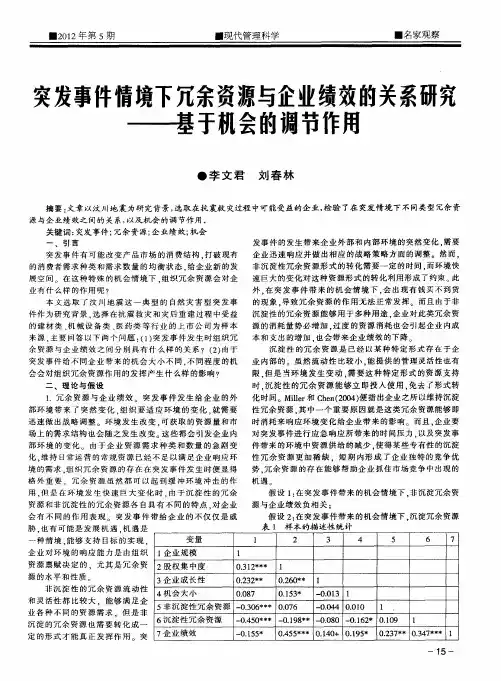
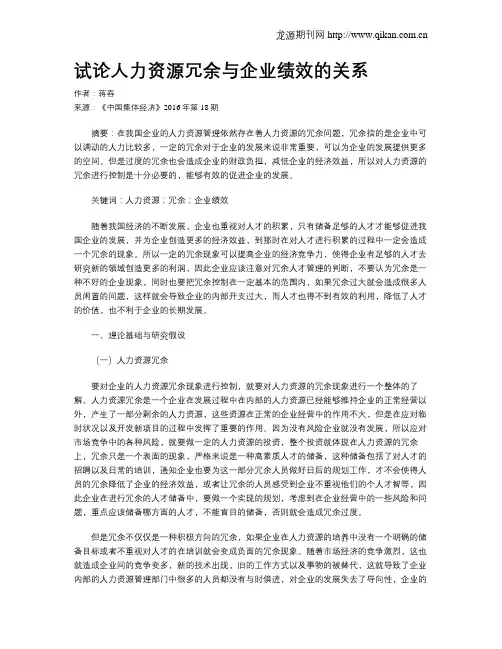
试论人力资源冗余与企业绩效的关系作者:蒋春来源:《中国集体经济》2016年第18期摘要:在我国企业的人力资源管理依然存在着人力资源的冗余问题,冗余指的是企业中可以调动的人力比较多,一定的冗余对于企业的发展来说非常重要,可以为企业的发展提供更多的空间。
但是过度的冗余也会造成企业的财政负担,减低企业的经济效益,所以对人力资源的冗余进行控制是十分必要的,能够有效的促进企业的发展。
关键词:人力资源;冗余;企业绩效随着我国经济的不断发展,企业也重视对人才的积累,只有储备足够的人才才能够促进我国企业的发展,并为企业创造更多的经济效益,到那时在对人才进行积累的过程中一定会造成一个冗余的现象。
所以一定的冗余现象可以提高企业的经济竞争力,使得企业有足够的人才去研究新的领域创造更多的利润,因此企业应该注意对冗余人才管理的判断,不要认为冗余是一种不好的企业现象,同时也要把冗余控制在一定基本的范围内,如果冗余过大就会造成很多人员闲置的问题,这样就会导致企业的内部开支过大,而人才也得不到有效的利用,降低了人才的价值,也不利于企业的长期发展。
一、理论基础与研究假设(一)人力资源冗余要对企业的人力资源冗余现象进行控制,就要对人力资源的冗余现象进行一个整体的了解。
人力资源冗余是一个企业在发展过程中在内部的人力资源已经能够维持企业的正常经营以外,产生了一部分剩余的人力资源,这些资源在正常的企业经营中的作用不大,但是在应对临时状况以及开发新项目的过程中发挥了重要的作用。
因为没有风险企业就没有发展,所以应对市场竞争中的各种风险,就要做一定的人力资源的投资,整个投资就体现在人力资源的冗余上,冗余只是一个表面的现象,严格来说是一种高素质人才的储备,这种储备包括了对人才的招聘以及日常的培训,通知企业也要为这一部分冗余人员做好日后的规划工作,才不会使得人员的冗余降低了企业的经济效益,或者让冗余的人员感受到企业不重视他们的个人才智等,因此企业在进行冗余的人才储备中,要做一个实现的规划,考虑到在企业经营中的一些风险和问题,重点应该储备哪方面的人才,不能盲目的储备,否则就会造成冗余过度。
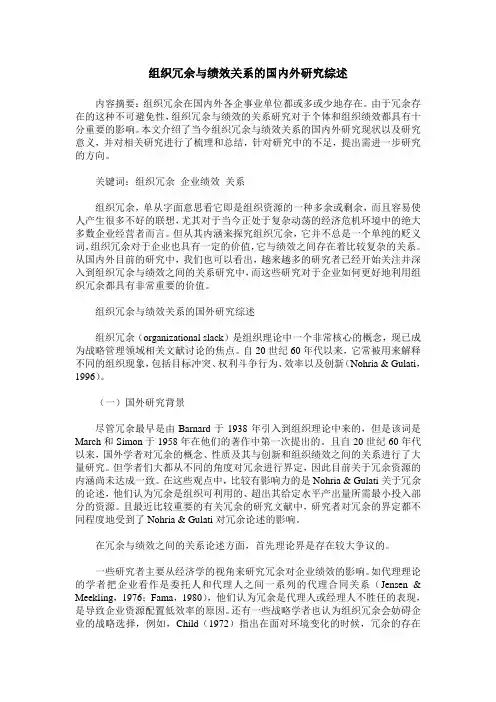
组织冗余与绩效关系的国内外研究综述内容摘要:组织冗余在国内外各企事业单位都或多或少地存在。
由于冗余存在的这种不可避免性,组织冗余与绩效的关系研究对于个体和组织绩效都具有十分重要的影响。
本文介绍了当今组织冗余与绩效关系的国内外研究现状以及研究意义,并对相关研究进行了梳理和总结,针对研究中的不足,提出需进一步研究的方向。
关键词:组织冗余企业绩效关系组织冗余,单从字面意思看它即是组织资源的一种多余或剩余,而且容易使人产生很多不好的联想,尤其对于当今正处于复杂动荡的经济危机环境中的绝大多数企业经营者而言。
但从其内涵来探究组织冗余,它并不总是一个单纯的贬义词,组织冗余对于企业也具有一定的价值,它与绩效之间存在着比较复杂的关系。
从国内外目前的研究中,我们也可以看出,越来越多的研究者已经开始关注并深入到组织冗余与绩效之间的关系研究中,而这些研究对于企业如何更好地利用组织冗余都具有非常重要的价值。
组织冗余与绩效关系的国外研究综述组织冗余(organizational slack)是组织理论中一个非常核心的概念,现已成为战略管理领域相关文献讨论的焦点。
自20世纪60年代以来,它常被用来解释不同的组织现象,包括目标冲突、权利斗争行为、效率以及创新(Nohria & Gulati,1996)。
(一)国外研究背景尽管冗余最早是由Barnard于1938年引入到组织理论中来的,但是该词是March和Simon于1958年在他们的著作中第一次提出的。
且自20世纪60年代以来,国外学者对冗余的概念、性质及其与创新和组织绩效之间的关系进行了大量研究。
但学者们大都从不同的角度对冗余进行界定,因此目前关于冗余资源的内涵尚未达成一致。
在这些观点中,比较有影响力的是Nohria & Gulati关于冗余的论述,他们认为冗余是组织可利用的、超出其给定水平产出量所需最小投入部分的资源。
且最近比较重要的有关冗余的研究文献中,研究者对冗余的界定都不同程度地受到了Nohria & Gulati对冗余论述的影响。
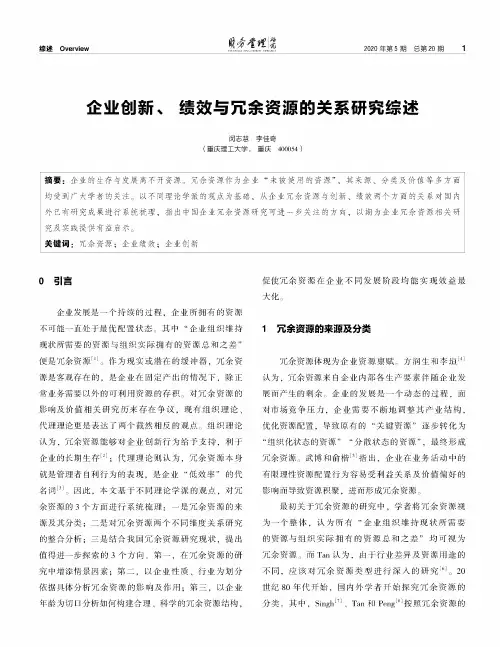
企业创新、绩效与冗余资源的关系研究综述闵志慧李佳奇(重庆理工大学,重庆400054)摘要:企业的生存与发展离不开资源。
冗余资源作为企业“未被使用的资源”,其来源、分类及价值等多方面均受到广大学者的关注。
以不同理论学派的观点为基础,从企业冗余资源与创新、绩效两个方面的关系对国内外已有研究成果进行系统梳理,指出中国企业冗余资源研究可进一步关注的方向,以期为企业冗余资源相关研究及实践提供有益启示。
关键词:冗余资源;企业绩效;企业创新0引言企业发展是一个持续的过程,企业所拥有的资源不可能一直处于最优配置状态。
其中“企业组织维持现状所需要的资源与组织实际拥有的资源总和之差”便是冗余资源[l]o作为现实或潜在的缓冲器,冗余资源是客观存在的,是企业在固定产出的情况下,除正 常业务需要以外的可利用资源的存积。
对冗余资源的影响及价值相关研究历来存在争议,现有组织理论、代理理论更是表达了两个截然相反的观点。
组织理论认为,冗余资源能够对企业创新行为给予支持,利于企业的长期生存⑵;代理理论则认为,冗余资源本身就是管理者自利行为的表现,是企业“低效率”的代名词[3]o因此,本文基于不同理论学派的观点,对冗余资源的3个方面进行系统梳理:一是冗余资源的来源及其分类;二是对冗余资源两个不同维度关系研究的整合分析;三是结合我国冗余资源研究现状,提出值得进一步探索的3个方向。
第一,在冗余资源的研究中增添情景因素;第二,以企业性质、行业为划分依据具体分析冗余资源的影响及作用;第三,以企业年龄为切口分析如何构建合理、科学的冗余资源结构,促使冗余资源在企业不同发展阶段均能实现效益最大化。
1冗余资源的来源及分类冗余资源体现为企业资源禀赋。
方润生和李垣[4]认为,冗余资源来自企业内部各生产要素伴随企业发展而产生的剩余。
企业的发展是一个动态的过程,面对市场竞争压力,企业需要不断地调整其产业结构,优化资源配置,导致原有的“关键资源”逐步转化为“组织化状态的资源”“分散状态的资源”,最终形成冗余资源。
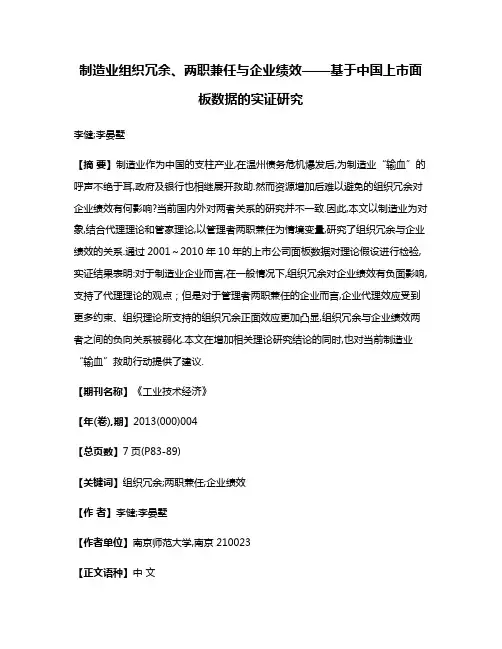
制造业组织冗余、两职兼任与企业绩效——基于中国上市面板数据的实证研究李健;李晏墅【摘要】制造业作为中国的支柱产业,在温州债务危机爆发后,为制造业“输血”的呼声不绝于耳,政府及银行也相继展开救助.然而资源增加后难以避免的组织冗余对企业绩效有何影响?当前国内外对两者关系的研究并不一致.因此,本文以制造业为对象,结合代理理论和管家理论,以管理者两职兼任为情境变量,研究了组织冗余与企业绩效的关系.通过2001~2010年10年的上市公司面板数据对理论假设进行检验,实证结果表明:对于制造业企业而言,在一般情况下,组织冗余对企业绩效有负面影响,支持了代理理论的观点;但是对于管理者两职兼任的企业而言,企业代理效应受到更多约束、组织理论所支持的组织冗余正面效应更加凸显,组织冗余与企业绩效两者之间的负向关系被弱化.本文在增加相关理论研究结论的同时,也对当前制造业“输血”救助行动提供了建议.【期刊名称】《工业技术经济》【年(卷),期】2013(000)004【总页数】7页(P83-89)【关键词】组织冗余;两职兼任;企业绩效【作者】李健;李晏墅【作者单位】南京师范大学,南京210023【正文语种】中文【中图分类】F30引言2010年中国在全球制造业产值中的比重上升到19.8%,成为世界制造业第一大国。
并且从2004~2010年,中国制造业对我国GDP的贡献率基本上超过了40%(除2009年的37%),因此制造业的健康发展对我国经济至关重要。
随着温州债务危机的爆发,制造业尤其是其中的中小型企业缺钱、缺资源的声音不绝于耳。
在政府、银行加紧给制造业“输血”救助的同时,由于企业并不总是处于资源利用效率最高的状态、资源实际控制者的有限理性[1],都将使得资源闲置难以避免[2]。
因此对制造业企业组织冗余与企业绩效关系的研究,对于当前制造业“输血”救助行动的有效性具有重要的现实意义。
目前尽管学术界基本认同组织冗余对企业绩效存在重要影响,但两者之间的关系仍然存在较大争议:一方面代理理论认为冗余资源容易引发代理问题,当经理人员与委托人的目标不一致时,经理人员更有可能利用组织冗余的资源进行分散化投资和各种面子工程[3]。

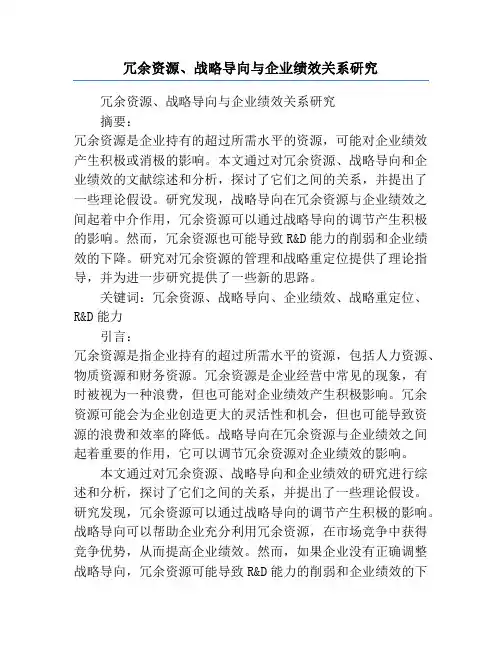
冗余资源、战略导向与企业绩效关系研究冗余资源、战略导向与企业绩效关系研究摘要:冗余资源是企业持有的超过所需水平的资源,可能对企业绩效产生积极或消极的影响。
本文通过对冗余资源、战略导向和企业绩效的文献综述和分析,探讨了它们之间的关系,并提出了一些理论假设。
研究发现,战略导向在冗余资源与企业绩效之间起着中介作用,冗余资源可以通过战略导向的调节产生积极的影响。
然而,冗余资源也可能导致R&D能力的削弱和企业绩效的下降。
研究对冗余资源的管理和战略重定位提供了理论指导,并为进一步研究提供了一些新的思路。
关键词:冗余资源、战略导向、企业绩效、战略重定位、R&D能力引言:冗余资源是指企业持有的超过所需水平的资源,包括人力资源、物质资源和财务资源。
冗余资源是企业经营中常见的现象,有时被视为一种浪费,但也可能对企业绩效产生积极影响。
冗余资源可能会为企业创造更大的灵活性和机会,但也可能导致资源的浪费和效率的降低。
战略导向在冗余资源与企业绩效之间起着重要的作用,它可以调节冗余资源对企业绩效的影响。
本文通过对冗余资源、战略导向和企业绩效的研究进行综述和分析,探讨了它们之间的关系,并提出了一些理论假设。
研究发现,冗余资源可以通过战略导向的调节产生积极的影响。
战略导向可以帮助企业充分利用冗余资源,在市场竞争中获得竞争优势,从而提高企业绩效。
然而,如果企业没有正确调整战略导向,冗余资源可能导致R&D能力的削弱和企业绩效的下降。
一、冗余资源与企业绩效的影响机制冗余资源对企业绩效的影响机制是多样的。
一方面,冗余资源可以增加企业的创新能力和灵活性。
创新是企业持续发展的重要动力,而冗余资源可以为企业提供创新所需的实验环境和支持。
此外,冗余资源还可以提供企业应对市场变化和风险的能力,帮助企业更好地适应外部环境的变化。
另一方面,冗余资源也可能导致资源的浪费和效率的降低。
如果企业无法有效管理和利用冗余资源,资源可能被闲置或浪费,导致资源效率的下降。
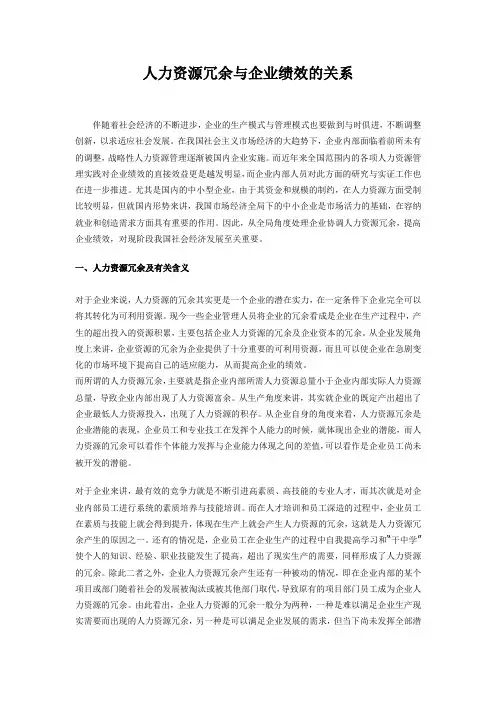
人力资源冗余与企业绩效的关系伴随着社会经济的不断进步,企业的生产模式与管理模式也要做到与时俱进,不断调整创新,以求适应社会发展。
在我国社会主义市场经济的大趋势下,企业内部面临着前所未有的调整,战略性人力资源管理逐渐被国内企业实施。
而近年来全国范围内的各项人力资源管理实践对企业绩效的直接效益更是越发明显,而企业内部人员对此方面的研究与实证工作也在进一步推进。
尤其是国内的中小型企业,由于其资金和规模的制约,在人力资源方面受制比较明显,但就国内形势来讲,我国市场经济全局下的中小企业是市场活力的基础,在容纳就业和创造需求方面具有重要的作用。
因此,从全局角度处理企业协调人力资源冗余,提高企业绩效,对现阶段我国社会经济发展至关重要。
一、人力资源冗余及有关含义对于企业来说,人力资源的冗余其实更是一个企业的潜在实力,在一定条件下企业完全可以将其转化为可利用资源。
现今一些企业管理人员将企业的冗余看成是企业在生产过程中,产生的超出投入的资源积累,主要包括企业人力资源的冗余及企业资本的冗余。
从企业发展角度上来讲,企业资源的冗余为企业提供了十分重要的可利用资源,而且可以使企业在急剧变化的市场环境下提高自己的适应能力,从而提高企业的绩效。
而所谓的人力资源冗余,主要就是指企业内部所需人力资源总量小于企业内部实际人力资源总量,导致企业内部出现了人力资源富余。
从生产角度来讲,其实就企业的既定产出超出了企业最低人力资源投入,出现了人力资源的积存。
从企业自身的角度来看,人力资源冗余是企业潜能的表现,企业员工和专业技工在发挥个人能力的时候,就体现出企业的潜能,而人力资源的冗余可以看作个体能力发挥与企业能力体现之间的差值,可以看作是企业员工尚未被开发的潜能。
对于企业来讲,最有效的竞争力就是不断引进高素质、高技能的专业人才,而其次就是对企业内部员工进行系统的素质培养与技能培训。
而在人才培训和员工深造的过程中,企业员工在素质与技能上就会得到提升,体现在生产上就会产生人力资源的冗余,这就是人力资源冗余产生的原因之一。
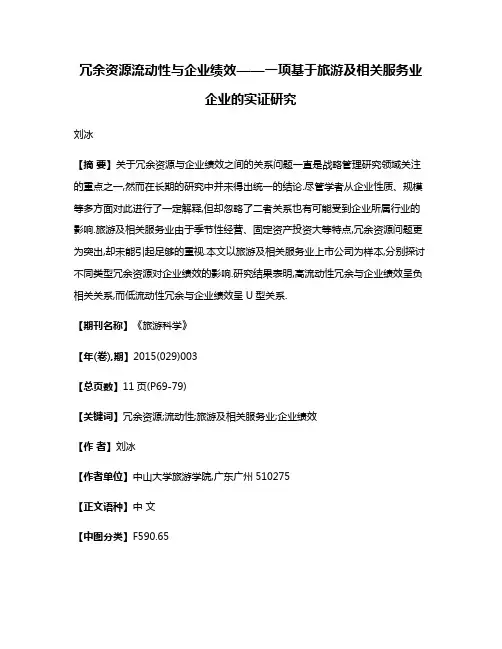
冗余资源流动性与企业绩效——一项基于旅游及相关服务业企业的实证研究刘冰【摘要】关于冗余资源与企业绩效之间的关系问题一直是战略管理研究领域关注的重点之一,然而在长期的研究中并未得出统一的结论.尽管学者从企业性质、规模等多方面对此进行了一定解释,但却忽略了二者关系也有可能受到企业所属行业的影响.旅游及相关服务业由于季节性经营、固定资产投资大等特点,冗余资源问题更为突出,却未能引起足够的重视.本文以旅游及相关服务业上市公司为样本,分别探讨不同类型冗余资源对企业绩效的影响.研究结果表明,高流动性冗余与企业绩效呈负相关关系,而低流动性冗余与企业绩效呈U型关系.【期刊名称】《旅游科学》【年(卷),期】2015(029)003【总页数】11页(P69-79)【关键词】冗余资源;流动性;旅游及相关服务业;企业绩效【作者】刘冰【作者单位】中山大学旅游学院,广东广州510275【正文语种】中文【中图分类】F590.65处在转型经济环境中的绝大多数中国企业经营者总是面临两难的境地:是最大限度地积累各类资源以降低环境不确定性带来的风险?还是尽可能地削减过剩的产能和人员以避免重复资源所导致的浪费?长期以来,理论界也从未停止过对冗余资源的探讨。
无论是组织理论还是经济理论,在关于冗余资源与企业绩效关系问题的研究中,都未能得出统一的结论。
冗余,究竟是企业经历动荡环境中的一种缓冲还是企业发展中的一种阻碍?尽管学者结合企业规模、企业年龄、企业性质等因素对不同的实证结果进行了一定的解释,却忽略了冗余资源也可能因企业所属行业差别而表现出不同的特征,因此针对特定的行业背景对冗余资源与企业绩效关系的研究并不多见。
与其他行业相比,旅游及相关服务业①本研究目的是基于旅游及相关服务业的行业特征共性,探讨旅游企业、旅游相关服务业企业的冗余资源与企业绩效的关系,因此对旅游企业与旅游相关服务业企业不做区分。
本文“旅游业”即指“旅游及相关服务业”,“旅游企业”即指“旅游及相关服务业企业”;如无特别说明,下文同。
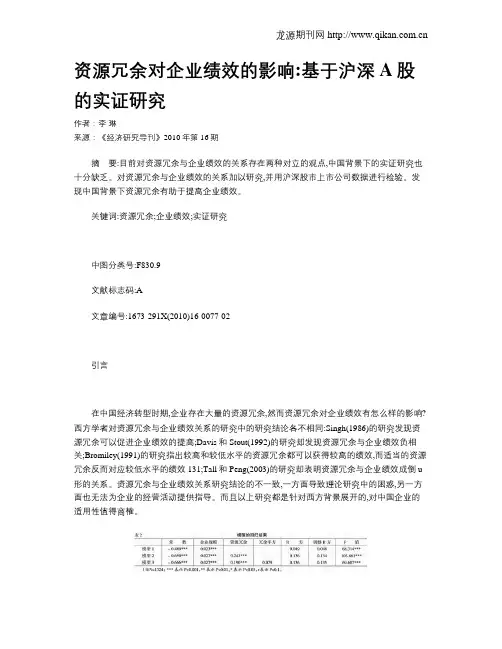
资源冗余对企业绩效的影响:基于沪深A股的实证研究作者:李琳来源:《经济研究导刊》2010年第16期摘要:目前对资源冗余与企业绩效的关系存在两种对立的观点,中国背景下的实证研究也十分缺乏。
对资源冗余与企业绩效的关系加以研究,并用沪深股市上市公司数据进行检验。
发现中国背景下资源冗余有助于提高企业绩效。
关键词:资源冗余;企业绩效;实证研究中图分类号:F830.9文献标志码:A文章编号:1673-291X(2010)16-0077-02引言在中国经济转型时期,企业存在大量的资源冗余,然而资源冗余对企业绩效有怎么样的影响?西方学者对资源冗余与企业绩效关系的研究中的研究结论各不相同:Singh(1986)的研究发现资源冗余可以促进企业绩效的提高;Davis和Stout(1992)的研究却发现资源冗余与企业绩效负相关;Bromiley(1991)的研究指出较高和较低水平的资源冗余都可以获得较高的绩效,而适当的资源冗余反而对应较低水平的绩效131;Tall和Peng(2003)的研究却表明资源冗余与企业绩效成倒u 形的关系。
资源冗余与企业绩效关系研究结论的不一致,一方面导致理论研究中的困惑,另一方面也无法为企业的经营活动提供指导。
而且以上研究都是针对西方背景展开的,对中国企业的适用性值得商榷。
国内对资源冗余与企业绩效关系的研究也尚无定论,有学者认为企业绩效随资源冗余的增加而降低,资源冗余是企业低效率的重要原因;也有学者提出资源冗余可以促进技术创新,帮助企业获得好的绩效。
然而这些研究基本停留在理论层面,实证研究十分缺乏。
一、研究综述资源冗余是“一种过量的、能够被控制者随意使用的资源”,反映了企业资源的充裕程度。
基于资源的观点认为,资源是企业建立和保持竞争优势的基础,资源冗余减轻了企业内部的限制,可以为进行结果不确定的计划提供支持,有利于企业的创新。
而且,拥有资源冗余的企业可以更加自由的对竞争者的行动作出反应。
充足的资源使企业可以有选择的采取行动来适应环境变化,帮助企业减轻环境变化带来的冲击,冗余资源成为企业应对环境变化冲击的手段。
人力资源冗余与企业绩效的关系王迎华神华新疆能源有限责任公司物业管理公司【摘要】人力资源是企业生存和发展的关键,是企业的核心。
人力资源冗余与企业的绩效之间存在着密切的联系,保持适度的人力资源冗余对于提高企业的绩效具有非常重要的意义。
本文将对人力资源冗余的形成和特点进行深入的分析,并在此基础上研究其与企业绩效之间的关系。
以期为我国企业的发展提供一些参考。
【关键词】人力资源冗余企业绩效关系研究近年来,随着社会经济的飞速发展,企业中不断出现人力资源冗余的问题,能否正确认识和妥善处理这一问题,对企业的经济效益和生存发展都有着非常重大的意义。
一、人力资源冗余对于企业而言,冗余是指企业中存在的潜在资源,它能在需要的时候被转化为可利用的目标。
1996年,Nohria与Gulati将企业的冗余资源定义为:“企业在正常的生产过程中,超出了最低必须的投入所产生的资源存积,它主要包括多余的人力资源、未使用的资本以及不必要的资本费用等,同时还包括未开发的、能增加产出的各种机会。
”冗余为企业的的创新提供了重要的资源,它可以提高企业对环境变化的适应能力,进而提高企业的绩效。
二、人力资源冗余的含义所谓人力资源冗余,主要是指企业所拥有的实际人力资源总量超过了现有业务的需求量而出现的人力资源富余,实际上是企业在生产某种既定产出时,超出了当时的最低人力资源投入,因此而产生的人力资源存积以及人力资源价值的潜力。
从企业自身来看,个人具有较大的潜力。
因为岗位和专业的分工,使得他们只能发挥个人的一部分能力,所以人力资源冗余也可以被看作是企业个体能够发挥的能力与已经发挥的能力之间的差值,即企业员工未能发挥出来的潜能。
三、为什么会形成人力资源冗余对于一个企业而言,企业要发展就必须经常引进高素质的专业人才或有计划地对企业现有的职工进行素质和技能培训。
在此过程中。
企业职工的知识和技能就会超过现实的需要,因此而产生人力资源的冗余;同时,企业职工在具体的生产过程中也会不断的学习,从而提高了自身的知识和技能,这样一来,也会超过现实的需要,因此有形成了人力资源的冗余;除以上两种主动式的产生人力资源冗余的情况外,还有一种是被动式的产生人力资源冗余的情况,即当企业中的某个岗位或技术项目随着社会经济的发展而逐渐被淘汰时,原来该岗位或技术项目上的员工就成为企业冗余的人力资源。
一、研究背景国际环境日趋复杂,全球科技和产业竞争更趋激烈,大国战略博弈进一步聚焦制造业。
中国制造业大而不强,转型升级任务紧迫而艰巨。
国家“十四五”规划和《2035年远景目标纲要》明确提出,要加快制造强国建设,促进先进制造业和现代服务业深度融合,增大制造企业的服务投入和服务产出,催生新服务,促进制造业服务化发展。
然而,自身创新资源不足、服务创新落后是现阶段中国制造企业服务化转型升级中面临的严峻问题。
在此背景下,制造企业开始重视冗余资源,尝试利用冗余资源来扩充服务创新资源。
但如何运用冗余资源加以整合利用从而获得竞争优势,成为制造企业普遍关注的问题。
冗余资源及其对企业创新的影响已经成为创新管理研究领域的重要内容,学者们已普遍认可冗余资源的重要性。
现有研究表明,冗余资源能够缓解资源危机[1]、克服环境变化、优化配置内部资源[2]、缓解内部冲突[3]、促进企业成长等。
但是,制造企业的冗余资源研究还存在以下问题:首先,从资源基础观角度来看,现有制造企业服务创新主要集中在外部资源获取、跨界搜索等方面,缺少内部冗余资源应用的相关研究,目前学者较少聚焦于冗余资源与服务创新绩效的关系,大多数学者关注技术、产品创新,而鲜有研究关注企业的服务创新[4],无法全面客观地了解冗余资源与服务创【基金项目】湖南省自然科学基金项目,供应链外部整合、复合式能力对中国制造企业服务创新绩效的影响:关系质量和环境不确定性的调节作用,编号:2021JJ30582;湖南省社会科学成果评审委员会课题,产业融合背景下湖南制造业服务化路径、模式与对策研究,编号:XSP21YBZ167;湖南省教育厅重点项目,跨界搜索、资源拼凑对中国制造企业服务创新绩效的影响机制研究,编号:22A0290。
【作者简介】刘保平(通讯作者),南华大学经济管理与法学学院,副教授,管理学博士,研究方向:企业管理;张冰,南华大学经济管理与法学学院,硕士研究生,研究方向:制造企业服务创新、服务创新管理;曾经莲,南华大学经济管理与法学学院,讲师,管理学博士,研究方向:制造业服务化、服务创新管理。
研发投入、冗余资源与企业绩效的关系研究作者:蒋卫平刘黛蒂来源:《财经理论与实践》2016年第05期摘要:采用创业板企业2010~2014年数据为研究对象,实证分析研发投入与企业绩效的关系,探讨冗余资源对于二者关系的调节效应。
结果表明,我国创业板企业研发投入强度与当期绩效显著负相关,而与滞后一至三期企业绩效显著正相关。
考虑企业冗余资源的影响,进一步研究发现,沉淀性冗余资源和非沉淀性冗余资源对研发投入强度与企业绩效的关系分别具有负向和正向的调节效应,说明沉淀性冗余资源不利于企业研发绩效的提升,而非沉淀性冗余资源则可以有效促进企业进行创新研发,提高研发效率,最终提升企业绩效。
关键词:研发投入;沉淀性冗余;非沉淀性冗余;企业绩效中图分类号:F223文献标识码: A文章编号:1003-7217(2016)05-0057-06一、引言研发投入对企业绩效的影响,学者们结论不一。
促进论认为研发投入有利于生产效率或企业绩效水平的提升;而抑制论则指出,研发投入阻碍了效率或绩效的稳步增长;不确定性论则认为研发投入对产出效率或企业绩效的影响尚不明确。
Dimmick和Murray(1978)、Palmer和Wiseman(1999)研究指出冗余资源作为企业资金短缺时的缓冲器,与企业的风险承担水平密切相关,能在一定程度上增强企业能力实现创新[1,2]。
Sharfmanetal(1988)研究表明企业拥有的冗余资源数量与企业资源配置灵活度呈正相关关系,且冗余资源有利于增强企业对研发活动不确定性风险的承受度,从而促进企业实施持续创新投资[3]。
企业行为理论认为,组织冗余作为企业行为的基本驱动因素,有必要将其纳入到企业风险承担与绩效关系研究的框架之中[4]。
资源基础观认为,冗余资源作为企业可利用资源之一,企业对其利用能力因其灵活性和适用性不同而有所差异。
本文将冗余资源、研发投入与企业绩效整合到同一研究框架,在分析研发投入对企业绩效影响的基础上,进一步探究企业冗余资源对两者关系的调节效应,希望为创业板上市公司制定更优研发策略,提高研发效率,合理安排资源等提供相应的决策参考。
企业创新、绩效与冗余资源的关系研究综述摘要:企业创新是提高企业核心竞争力、实现可持续发展的关键要素之一。
本文通过对企业创新、绩效以及冗余资源的相关研究进行综述,旨在探讨它们之间的关系,并提出一些未来研究的方向。
文章分为四个部分:第一部分介绍企业创新、绩效和冗余资源的基本概念;第二部分探讨企业创新对绩效的影响;第三部分分析冗余资源对企业创新和绩效的影响;第四部分总结,并提出未来研究的展望。
1. 企业创新、绩效和冗余资源的基本概念企业创新是指企业为了解决问题、提高产品、服务或流程而采取的新思路或新方法。
它可以是技术创新、产品创新、组织创新等。
企业绩效是企业在经营活动中实现的目标和结果的度量,通常包括财务绩效、市场表现、员工满意度等多个方面。
冗余资源是指企业拥有但没有充分利用的资源,包括闲置的人力、资金、设备等。
它们之间存在着密切的关系。
2. 企业创新对绩效的影响企业创新对绩效具有重要影响。
首先,创新可以提高产品质量和技术水平,使企业在市场竞争中占据优势地位,进而提高市场份额和销售额。
其次,创新可以降低企业的成本和风险,创造更高的利润率。
此外,创新可以激发员工的创造力和积极性,提高员工满意度和团队效能。
总的来说,企业创新可以提高绩效,从而促进企业的发展。
3. 冗余资源对企业创新和绩效的影响冗余资源对企业创新和绩效也有一定影响。
一方面,适度的冗余资源可以提供给企业灵活性和创新的空间。
它可以作为创新的动力源泉,提供支持和保障。
另一方面,过多的冗余资源可能导致资源浪费和效率低下。
企业过度依赖冗余资源,可能忽视了对其他资源的合理配置和利用,进而影响企业的创新和绩效。
因此,企业需要找到冗余资源的适度度,并合理利用它们,以实现最佳的创新和绩效效果。
4. 总结与展望本文综述了企业创新、绩效和冗余资源之间的关系,发现创新和绩效之间存在密切的正向关系,冗余资源对创新和绩效的影响则是多方面的,需要通过合理配置和利用来发挥最佳效果。
作者: 蒋春燕[1];赵曙明[2]
作者机构: [1]香港中文大学工商管理学院;[2]南京大学商学院
出版物刊名: 管理世界
页码: 108-115页
主题词: 上市公司;中国;组织冗余;企业绩效;公司治理结构;证券市场;评价指标体系;时间序列
摘要:尽管学者对组织冗余和绩效的关系尚无定论,但是在转型经济中,人们通常认为组织的绩效随着冗余的增加而降低,组织冗余是企业特别是国有企业低绩效的公共原因。
可是最近的一些实证研究表明,在转型经济中,组织冗余和绩效的关系并不总是线性负的,也可能是U 型(组织冗余和绩效一开始是负的关系,但当冗余超过一定程度时,他们的关系就成为正相关了)和倒置U型(组织冗余有一个理想的范围,低于或高于这个范围对绩效的影响都是负的)。
本文使用中国278家上市公司从1994年到2001年的数据作为样本进行分析,提出了一个新的组织冗余和绩效之间关系模型,该模型包括了几乎所有文献中所出现的看似矛盾的组织冗余和绩效的关系,具有一定的理论和实践意义。
I.J.Modern Education and Computer Science, 2011, 1, 1-8Published Online February 2011 in MECS (/)The Relationship between Slack Resources and Performance: An Empirical Study from ChinaHeping ZhongSchool of Economics and Management, Xuchang University, Xuchang, ChinaEmail: hepingz2004@Abstract—Although organizational research posits various relationships between a firm’s slack resources and performance, findings to date have been ambiguous. The purpose of this study is to attempt to reconcile previous views of the relationship between slack resources and performance through employing empirical analysis based on survey data from 47 pharmaceutical and chemical firms in Henan Province of China. The results indicate that the relationship between slack resources and the performance is inverse N-shaped. Results provide evidence of a curvilinear relationship between slack resources and performance and broadly demonstrate that relationships differ based on industry circumstances and slack resources. Additionally, this study is the first to empirically identify an inverse N-shaped relationship between slack resources and performance, indicating that, in certain industry circumstances, little and much slack resources are bad for performance. Overall, results highlight the importance of additional research into intervening factors impacting the slack–performance relationship.Index Terms—slack resources, performance, software application, inverse N-shaped curve, empirical analysis, pharmaceutical and chemical industry, pharmaceutical and chemical firm managementI.I NTRODUCTIONKeeping sustainable development is always an ultimate aim for managers in firms. From the viewpoint of the resource-based theory, a firm’s unique portfolio of tangible and intangible resources influences the extent and direction of a firm’s expansion. In this regard, numerous studies have proposed that resources enable firms to create static and dynamic synergies by applying resources required for sustainable development [1]. Thus, a firm’s performance and development is influenced by how the management team conceptualizes and uses a firm’s resources. Some scholars explore the relationship of resources, performance and growth from the perspective of total resources [2]; but classic views of resource-based argued the importance of resource slack as a driver of growth rather than the total quantity of resources possessed by a firm [3]. Slack is a dynamic quantity that represents the difference between the resources currently possessed by a firm and the resource demands of the current business. The slack of resources is important because two firms may possess the same level of resources but differ in the resource exploiting of their current business. Hence, the two firms would have different levels of slack and thus also differ in their growth potential [2]. Consequently, how to optimize firm slack resource allocation and its impact on performance has substantive theoretical and practical implications. However, despite the importance of firm slack resource allocation, the existing literature provides no compelling answers regarding whether slack resources facilitates or inhibits performance [4-7]. How does slack resources affect firm performance? Organization theorists typically argue that, despite its costs, slack resources buffers a firm’s technical core from environmental turbulence, and thus enhances its performance [3,6,8,9]. In contrast, agency theorists often suggest that slack resources is a source of agency problems, which breeds inefficiency, inhibits risk-taking, and hurts performance [6,10,11]. Rather than weigh in on one side of the debate for or against the performance-enhancing benefits of slack resources, some scholars have attempted to reconcile these perspectives and proposed an inverted U-shaped relationship between slack resoureces and performance [6,12,13]. The current literature has not reconciled these perspectives, and the issue regarding the influence of slack resources on performance remains an interesting but not fully explored issue [6,14].Several studies have attempted to build on previous findings and refine the relationship between slack resources and performance under different research settings, such as environmental contexts [6,15], industry contexts [3,7], and organizational characteristics [4,16,17]. Although these studies provide numerous useful insights, they leave room for further theorizing and empirical study [14]. First, previous empirical and theoretical investigations have tended to neglect competition condition in a industry. Firms in different competition condition require different amounts of slack resources to maintain their competitiveness. Therefore, it is necessary to consider the influences of different competition condition to avoid inconsistent results. Second, there are rare slack-performance studies on Chinese firms in current literatures, making it necessary to further study the relationship between slack resources and performance for Chinese firms because Chinese economy has been paid more and more attention all over the world.This study addresses the gaps in the literature by revisiting the relationship between slack resources and performance. To fill this void, this study employed a empirical analysis based on the sample from 472The Relationship between Slack Resources and Performance: An Empirical Study from Chinapharmaceutical and chemical firms in Henan Province to examine extant research results. Specifically, I focus on firms of a industry in China, based on survey data, to investigate whether slack resources contributes toward or inhibits firm performance.II.T HEORETICAL B ACKGROUND A ND H YPOTHESIS Although Barnard (1938) had discussed the role of slack in his early work, the specific label of ‘slack’ had not been coined until March and Simon published their seminal book in 1958 [6,18,19]. Cyert and March (1963) defined slack as ‘‘the difference between total resources and total necessary payments’’. This definition was followed by Bourgeois (1981) who added that ‘‘slack is that cushion of actual or potential resources which allows an organization to adapt successfully to internal pressures for adjustment or to external pressures for change in policy, as well as to initiate changes in strategy with respect to the external environment’’. Based on Bourgeois’ definition, Sharfman et al (1988) emphasized two characteristics of slack resources. One is that slack resources must be visible to the manager and employable in the future; the other characteristic is that different types of slack resources give managers dissimilar degrees of discretion in attempting to protect their firms from internal and external pressures. In addition, Nohria and Gulati (1996) defined slack resources as ‘‘the pool of resources in an organization that is in excess of the minimum necessary to produce a given level of organizational output’’ [20]. Moreover, they noted that these resources vary in type, including excess inputs (e.g., surplus employees, idle capacity, and capital expenditures) and overlooked or unexploited opportunities to increase outputs (e.g., margins and revenues to be gained from customer). Most recently, George (2005) defined slack as ‘‘potentially utilizable resources that can be diverted or redeployed for the achievement of organizational goals’’ [16].In summary, the literature has defined three facets of slack resources. First, slack resources is conceptually defined as resources not being used to the fullest extent possible. Second, slack resource characteristics include location [4] and accessibility (e.g., immediately versus deferred; [7]). Third, the two central purposes of slack resources are to act as a buffering mechanism to counter threats and also as a facilitator to exploit opportunities [21]. Why does slack resources emerge? The notion of endogenous growth of Penrose (1959) conceives firms as organic entities that cultivate and accumulate resources. Consequently, utilizing and leveraging these excess resources to capture external opportunities via managerial capabilities can drive firm growth. Penrose also pointed out that the attainments of excess resources are: indivisibility of resources, reuse of resources under different circumstances, and continual establishment of new productive services [14]. Based on the analysis all above, For the purposes of this study, slack resources will be defined as the resources readily available to an organization that are in excess of the minimum necessary to produce a given level of organizational output as well as the resources that are recoverable from being embedded in the firm [22], which is potentially utilizable resources that can be diverted or redeployed for the achievement of organizational goals [16].In theory, if a firm can identify and obtain resources for firm development from its interior or exterior timely and accurately, and maintain the sum of resources which meets the need of current business exactly, namely, the amount of slack resources is zero, the performance would reach the optimization, but it is impossible in practice. In order to respond to problems such as fluctuations in demand, a firm should have to keep some slack resources, which would lead to increasing cost. In order to fulfill the commitment to the staff, take on some social responsibilities and maintain harmony and stability of the organization, a firm should have to keep certain slack resources, this would also increase cost[23]. In pursuit of new goals and strategies, a firm should have to keep some slack resources[2], this would increase cost because the slack resources could not produce performance before new strategy is put in practice. So the conclusion is made that slack resources on the low side is negatively relatedto the performance of firms. Therefore, I suggest: Hypothesis1. Slack resources on the low side is negatively related to firm performance.When there is moderate slack resources, a firm has capability to explore and take advantage of opportunity provided by environment. The firms with slack resources have more strategic choices than those without slack resources [24,25], thereby they could choose strategic opportunities supported by slack resources available to enhance performance. Bromiely(1991)argued that slack resources related to competition provide strategic advantage for firms[24], as a result, there is a conclusion that to enhance slack resources related to competition will strengthen the firm’s competitive advantage and improve performance. In a word, moderate slack resources enables managers to pursue new targets and strategies actively, which may leads to improvement of firm performance. From the viewpoint of resource-based theory, the more slack resources a firm has, the more potential growth and better performance a firm has[2]. Accordingly, I could draw a conclusion that moderate slack resources will be positively related to the performance of firms. Therefore,I suggest the following hypotheses:Hypothesis2. Moderate slack resources is positively related to firm performance.On the other hand, slack resources is argued to be synonymous with waste, and a sign of managerial self-interest, incompetence, and sloth. From an agency theory perspective, managers inherently have a set of goals, such as the pursuit of power, prestige, money, and job security, that are not always aligned with those of principals, managers may use slack resources to engage in excessive diversification, empire-building, and on-the-job shirking[6]. These ‘‘slack resources as inefficiency’’ perspective posits that slack resources can encourage satisficing, politics, or self-serving managerial behaviors that hurt performance. At the same time, too much slack resources would encourage a firm to choose somesuboptimal projects [20]; and it would reduce firms’ performance. So, I can reach a conclusion that slack resources on the high side will be negatively related to the performance of firms. Therefore, I suggest the following hypotheses:Hypothesis3. Slack resources on the high side is negatively related to firm performance.There is little reason to believe that slack’s performance-enhancing effect—if any—is linear. In other words, there must be a limit beyond which further ‘hoarding’ of slack may backfire [6]. The relationship may well be an curvilinear. Some researchers have speculated that ‘there is an optimal level of slack resources for any given firm. If the firm exceeds that level, performance will go down [12,13], and an inverse U-shaped relationship between slack resources and performance is suggested [6]. Although Bromiley (1991) hypothesizes that the slack–performance relationship may be U-shaped—high and low slack resources is associated with better performance and moderate slack may lead to poorer performance—his results do not support this hypothesis and instead find a linear, positive relationship between slack resources and performance [6,24]. Behavioral arguments suggest that the impact slack resources on performance is decided by the relation between actual slack resources and target slack resources. Slack resources more or less than the target scope will urge a firm to take measures to improve performance. But the slack resources at the target scope will make a firm Satisfy present condition and don’t think enterprising, thus it reduce the firm’s performance [25]. In order for research on slack resources to advance, it is important to determine the optimum level of slack resources with better precision. Based on above discussion, I suggest hypothesis as following:Hypothesis4. There is a nonlinear inverted N-shaped relationship between slack resources and firm performance. That is to say, when slack resources is on the low side, slack resources is negatively related to firm performance; when slack resources is moderate, slack resources is positively related to firm performance; when slack resources is on the high side, slack resources is negatively related to firm performance.III.M ETHODOLOGYA. SamplesA questionnaire survey research method was used to seek responses from some typical firms in Henan Province of China. According to a sample frame provided by the correlative province bureau, we randomly selected 60 pharmaceutical and chemical firms as our study firms. Then, interviewers telephoned potential respondents and solicited personal interviews, and 47 firms accepted our survey. Descriptors of the sample are summarized in Table 1 to Table 4.Table 1 the distributing of respondents’ jobRespondent post Number Percentage (%)Intermediate manager19 40.4Senior manager 15 31.9General manager 6 12.8President 1 2.1Other 6 12.7 Table 2 the distributing of respondents’ educational backgroundEducation NumberPercentage(%)Senior high school 2 4.3Junior college 24 51.1Undergraduate 15 31.9Postgraduate 6 12.8Table 3 the distributing of firm ownership of respondentsFirm ownership Number Percentage (%)State-owned firm 10 21.3Private-owned firm 26 55.3Foreign capital-owned 6 12.8Other firm 5 10.6Table 4 the distributing of firm size of respondentsFirmsize Number Percentage(%) Oversize firm 1 2.1Big firm 12 25.5Middle firm 24 51.1Small firm 10 21.3Data was collected through intensive, in-depth interviews and usually one-to-one. Every interview wasabout one hour to 90 minutes in duration. Our interviewers had face-to-face communication and explanation with the top managers and relevant department directors of the firms; so that the demand of fulfilling the questionnaire was understand by them. Our interviewees were top firm managers, so they had a comparatively deep understanding of the firm’s slack resources and management activity, and their responsesto the questionnaire could actually demonstrate the firm’s condition.A total of 60 pharmaceutical and chemical firms were surveyed, 50 pharmaceutical and chemical firms provided complete information. Unfortunately, three sample firmswere ineligible because of company liquidation orinadequate completion of the survey questionnaire. That is, 47 pharmaceutical and chemical firms s had all the necessary data. The overall response rate for the survey was 83.3 percent (50 out of 60, and the effective rate was 78.3 percent (47/60). Moreover, to assess the non-response bias, this study compared the responding firms with the non-responding firms and found no significant differences in terms of firm size, age, employee numbers and assets. Therefore, the sample used by this research have better representative and can satisfy the research’s demand.B. Variables measureFirm performanceThere are great numbers of measurements on firm performance in present literatures, such as financial performance, strategy performance and so on. Because the statistical data is distempered or not willing to publish in many firms, it is hard to measure in quantity. But in their practical activities, managers collect and hold some useful information about their opponents in their industry, so they are clear about the comparative level of performance of their firm. Thereby, I use for reference measure item of prior studies[23,25], use the method of perception to measure comparative level of firm performance compared with its main opponents. So this paper chooses four items to measure firm performance: (1) sales growth; (2) asset-profit ratio; (3) increase of market share; and (4) net profit. In the questionnaires the answers were measured on five-point Likert scale ranging from 1, strongly draggle, to 5, strongly keep ahead. The Cronbach’s coefficient alpha for this scale is 0.927.Slack resourcesThe measure of slack resources borrow from the studies of Fang & Wang (2008)[26,27]. According to their definition and characteristics of the slack resources, this paper measure slack resources from the two aspects of the shared level of resources(reflecting the use range of resources as well as the conversion efficiency among differnet uses of the resources) and the multi-purpose in nature(reflecting the use range of resources), mainly choose three items to measure the level of slack resources: (1) The resource sharing level of various departments within the firm is very high; (2) New uses of existing resources in a firm are often found; (3) Some new resources or new mix of existing resources in a firm are often found. In the questionnaires the answers were measured on five-point Likert scale ranging from 1, strongly disagree, to 5, strongly agree. The Cronbach’s coefficient alpha for this scale is 0.840.Control variableLike prior studies, this study adopts total capital to measure the size of a firm, and take it as a control variable. The competition pressure that a firm faces is more big, the resources of the firm are more needed more effective exploitation. Since the competition condition among firms in different industry, this study also take the competition condition in a industry as a control variable, which is measured on 5-point Likert scale, using the scale from 1-5, which means respectively few competition, not severe competition, general, severe competition and verysevere competition. Moreover, slack resources is also time-dependent in both its accumulation and its deployment [8,9,13]. Older firms are more likely to possess large amounts of slack than younger firms and to be aware of their resource demands, conditions that help the older firms generate and deploy slack effectively [16]. Accordingly, this study also take the age of a firm as a control variable.C. Analyses and ResultsI test my model with the statistical software SPSS 13.0 and use exploratory factor analysis to test every index. In order to test the hypothesis all above, the paper draws on methods from Nohria & Gulati (1996), Jiang & Zhao(2004), Zhong et al(2008), uses once, twice, thrice regression equation model including independent variable to process hypothesis testing. The regression equation model is as follow:εβββββββ+++++++=36254321varvarvarcompagesizeeperformancI use the method of stepwise regression, and all variables are standardized before regresion analysis. If thrice regression equation model is better than model including once and twice regression equation, the N-shaped or inverted N-shaped relationship would be existed [16,23,25]. The result of hypothesis testing show as Table 5 to Table 7.Table 5 Model factor loading of the elements and Cronbach’s αElements discribing indicators (N=47) Factorloading Firm performance (Cronbach’s α= 0.927)V1 Sales growth 0.926V2 Asset profit ratio 0.918V3 Increase of market share 0.881V4 Net profit 0.906 Slack resources (Cronbach’s α = 0.840 )V5 The resource sharing level of various departmentswithin the firm is very high0.802V6 New uses of existing resources in a firm are oftenfound0.917V7 Some new resources or new mix of existingresources in a firm are often found0.889Table 6 Means, standard deviations and correlationsvariables mean s.d. 1 2341 Firm size 491381207022 Firm age 18.27316.33567 0.87+3Competition 4.109 0.9939 0.094 0.264+4 Slack resources3.7408 1.16424 -0.094 0.105 0.0205 Firm performance3.4330 0.80726 0.257+ 0.192 0.0120.372**** p <0.001 ** p <0.01 * p <0.05 +p <0.10Table 7 Regression model of slack resources and firm performance variables Model 1 Model 2 Model 3 Model 4Firm size 0.233 0.307* 0.269* 0.321* Firm age 0.231 0.158 0.130 0.101Competition -0.370*-0.405**-0.347*-0.387**Slack resources 0.476** 0.430** 0.934**Slack resources 2 -0.223 -0.306*Slack resources 3-0.581* F3.211* 6.558*** 6.073*** 6.426***R 2 0.211 0.428 0.472 0.539 Adjusted R 2 0.145 0.363 0.394 0.455*** p <0.001 ** p <0.01 * p <0.05 + p <0.10Note: Regression coefficients are standardized coefficientsReliability assessmentPrevious research suggests that, in the absence of archival data, self-reported measures are acceptable and often equally reliable, provided that data reliability is examined [6,28,29]. Although managers in China might be interested in reporting ‘politically correct’ behavior (i.e., painting ‘rosy pictures’), it was unlikely that the bias was systematic . In other words, there was no evidence that our informants always over- or under-reported certain data by a consistent margin [6].Moreover, I tested data reliability by using Cronbach’s alpha. Composite reliability assesses inter-item consistency, which was operationalized using the internal consistency method that is estimated using Cronbach’s alpha. Typically, reliability coefficients of 0.70 or higher are considered adequate [30,31]. Nunnally (1978) further states that permissible alpha values can be slightly lower (>0.60) for newer scales [31]. Although the constructs developed in this study are measured primarily on previously validated measurement items and strongly grounded in the literature, they are modified somewhat to suit the Chinese context. Therefore, an alpha value of0.60 was considered as the cut-off value [32]. As shown in Table 5, two Cronbach’s alpha values are more than0.80. These results suggest that the theoretical constructsexhibit good psychometric properties. FindingsDescriptive statistics and regression results are shown in Table 5 to Table 7, respectively. The results of exploratory factor analysis from table 1 indicate that factor loading and Cronbach’s alpha are more than 0.70,every index is in accordance with requirement ofhypothesis testing. Table7 presents results of the testing of the four hypotheses. Goodness-of-Fit test andsignificance test from Table 7 indicate that model 4 isbetter than model 2 and model 3. Model 4 contains everyhypothesis, that is negative relationship when there are slack resources on the low side, positive relationshipwhen there are moderate slack resources; negativerelationship when there are slack resources on the highside (934.04=β, p = 0.001; 306.05−=β, p = 0.027;581.06−=β, p =0.036). Meanwhile, collinearity andheteroscedasticity test indicate that there is nomulticollinearity problems and heteroscedasticity issues (relevant test data are ignored). Therefore, all hypothesesfrom hypothesis 1 to hypothesis 4 are supported by these testing. Regression curve as Fig. 1 (control variable is ignored).IV. D ISCUSSION A ND C ONCLUSIONContributionsIn this study, my contributions focus on the building of an inverted N-shaped model that clarify the relationship between slack resources and firm performance. Moving beyond Bromiley (1991), Tan and Peng(2003), Jiang and Zhao(2004), my work, to the best of my knowledge, presents the first set of evidence on such a relationship between slack resources and firm performance. I have advocated and documented a middle ground out of the intractable debate on the role of slackbetween organization and agency theories. Thus, the right question to ask is not whether slack is uniformly good or bad for performance, but rather, what range of slack is optimal for performance.Although this study’s findings provide support for the general proposition that there is a curvilinear relationship between slack resources and performance in at least one industry, my findings differ from former researches because I suggest an inverted N-shaped model between slack resources and firm performance. As such, it represents another demonstration that the seemingly contradictory attributions made to slack resources can be reconciled when explaining the impact of slack on performance. That is to say, my findings help reconcile the debate not by finding that one theory is more superior than the other, but by specifying the circumstances under which each is likely to be supported. The findings suggest (1) that organization theory is more insightful when a firm has moderate slack resources, and (2) that agency theory is more significantly supported when a firm has much or little slack resources. Therefore, theoretically, this paper calls for better specification on the nature of slack when advancing theory—in both developed and emerging economies—as opposed to simplified, onesided arguments such as ‘slack is good or bad’ typically found in the literature. Furthermore, this study uses different methods to measure slack resources, which is not only measure the slack of the amount of resources but also measure the slack of the value of resources. Therefore, this study’s finding is an important extension of the Tan and Peng (2003) findings in that it was based on using financial measures of slack.This study follows up on the suggestions of Tan and Peng(2003), Jiang and Zhao(2004) regarding further slack research. Specifically, this work answers the following question: how much slack enhance performance under a specific industry competition condition? The results of this empirical study elucidate the relationships between slack resources and performance, and thus go beyond the simple theoretical question of whether slack resources enhance performance. In summary, this paper contributes to the literature by theoretically arguing for a better specification of the nature of slack when engaging in the debate on the role of slack, empirically addressing this issue within the context of economic transitions such as China, and methodologically employing survey methods to obtain convergent results.Limitations and future research directionsDespite some contributions to the literature and certain practical applications, this study has limitations that should be addressed in future research. First, the cross-sectional data used in the study do not allow for causal interpretation among the factors, although we requested that the sample firms supply data for the most recent three-year period. Ideally, this study would have benefited from a time lag between the measurement of the independent and dependent variables in order for a causal relationship to be determined. I hope that this study will serve as a foundation for new studies in the future. A second limitation is that this study does not consider the different influences of different type slack resources such as available slack, recoverable slack on firm performance. Because different type slack resources have different character and value, the exploitation of different slack resources will produce different results. This should be a future research topic. Additionally, my findings and results are unique to the Chinese. Although, as the largest emerging economy, China has attracted significant research attention recently [33], future researchers need to explore the generalizability of my findings by conducting studies in different institutional environments (e.g., Chile, Hungary, India). Even within China, I need to caution that my findings probably only captured one snapshot during the evolution of China’s firm management reforms. While some issues confronting Chinese state-owned firms may be unique (e.g., managerial incentive to hoard slack), others may be relevant for non- state-owned firms as well (e.g., social networks and diffusion of the slack-hoarding behavior) [6,34]. Therefore, careful studies comparing and contrasting how slack affects strategy and performance among collective-, private-, and foreign-owned firms will be necessary [6,35,36,37].ConclusionSlack resources and performance exhibit complex curvilinear relationships in addition to simple nonlinear relationships. Balancing and optimizing slack is therefore a prerequisite for performance enhancing. Notably, different levels of slack resources have distinct impact on performance. Slack resources exhibit an inverse N-shaped relationship with performance. The results indicate that keeping moderate slack resources is propitious to firm development, but little and much slack resources may reduce firm performance. Therefore, it provides a firm a theoretical basis for a firm to cut slack resources. Restated, too much and too little slack resources can inhibit performance. Both slack resources should be optimized to maximize performance. Overall, I suggest that although both organization and agency theories are insightful to help us probe into the relationship between slack resources and firm performance during economic transitions, neither of them offers a complete picture. As a result, my findings call for a contingency perspective to specify the nature of slack when discussing its impact on firm performance.A CKNOWLEDGMENTThis paper is supported by Natural Science Foundation of China (70671111), the Soft Science Research Project of Henan Province (092400440088), the Natural Science Research Program of Henan Education department (2008A630041) and the Major Special Project of Xuchang University (2010ZD007).R EFERENCES[1]Foss, N.J. and Christensen, J.F., “A market-processapproach to corporate coherence”, Managerial and Decision Economics, 2001, Vol. 22 Nos 4/5, pp. 213-26.。